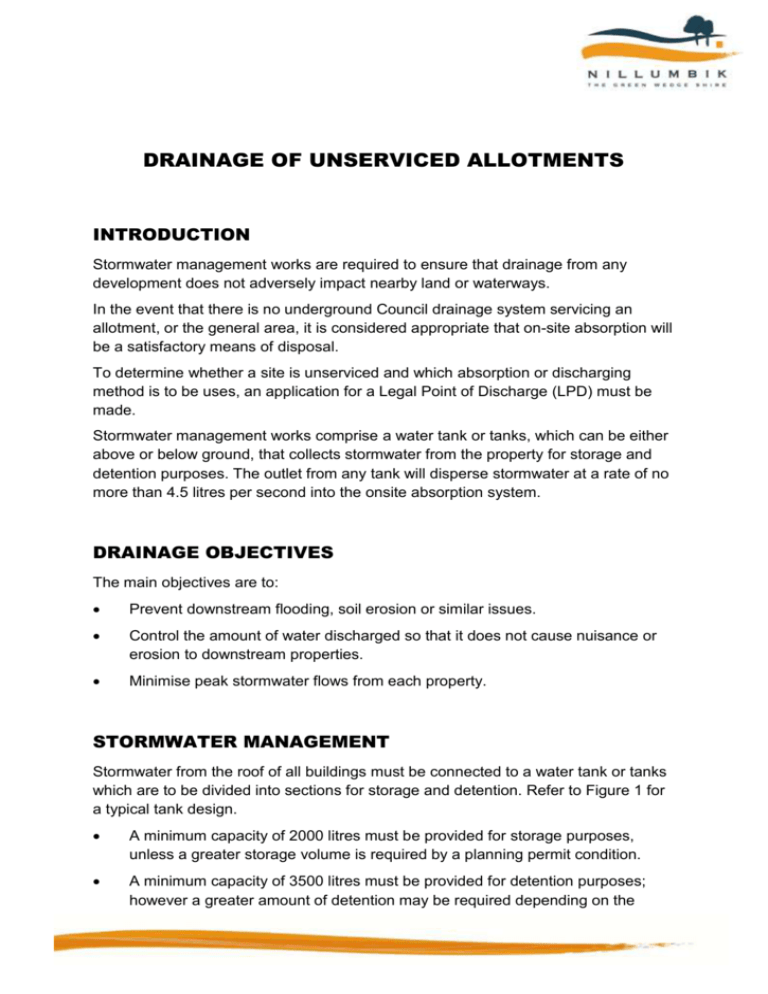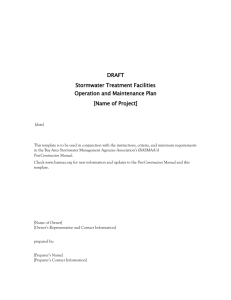Drainage of Unserviced Allotments
advertisement

DRAINAGE OF UNSERVICED ALLOTMENTS INTRODUCTION Stormwater management works are required to ensure that drainage from any development does not adversely impact nearby land or waterways. In the event that there is no underground Council drainage system servicing an allotment, or the general area, it is considered appropriate that on-site absorption will be a satisfactory means of disposal. To determine whether a site is unserviced and which absorption or discharging method is to be uses, an application for a Legal Point of Discharge (LPD) must be made. Stormwater management works comprise a water tank or tanks, which can be either above or below ground, that collects stormwater from the property for storage and detention purposes. The outlet from any tank will disperse stormwater at a rate of no more than 4.5 litres per second into the onsite absorption system. DRAINAGE OBJECTIVES The main objectives are to: Prevent downstream flooding, soil erosion or similar issues. Control the amount of water discharged so that it does not cause nuisance or erosion to downstream properties. Minimise peak stormwater flows from each property. STORMWATER MANAGEMENT Stormwater from the roof of all buildings must be connected to a water tank or tanks which are to be divided into sections for storage and detention. Refer to Figure 1 for a typical tank design. A minimum capacity of 2000 litres must be provided for storage purposes, unless a greater storage volume is required by a planning permit condition. A minimum capacity of 3500 litres must be provided for detention purposes; however a greater amount of detention may be required depending on the amount of impervious area on the property. To calculate the volume of detention required, refer to Figure 2. Stormwater from the water tank must disperse at a rate of no more than 4.5 litres per second into your onsite absorption system. To calculate the detention outlet size, refer to Figure 3. The overflow from the water tank and stormwater collected from any other impervious areas must be connected to the on-site absorption system. ON-SITE ABSORPTION SYSTEM An on-site absorption system contains a buried slotted pipe (agricultural pipe), placed in a trench of screenings, to allow stormwater to seep into the surrounding ground. The absorption system is to be constructed as follows: At the start of the absorption line, a distribution pit, 450 x 450 x 450mm is to be provided. The length of the absorption line is to be a minimum 9 metres in length. Absorption trench must be at least 450mm wide and between 315mm to 450mm deep. Drains are to be 90mm diameter agricultural pipes (minimum), laid level across the contour of the allotment (perpendicular to the slope of the land). All agricultural pipes shall be laid on a bedding of at least 75mm of 20mm screenings and covered with a minimum of 50mm of 20mm screenings. Layers of newspaper, building paper or other approved coverings must be spread on top of the screenings prior to backfilling with topsoil. The topsoil is to be a minimum 100mm in depth and is to be firmly compacted without displacing the pipes. The absorption trench must be no closer than 1 metre below (downhill) or 4 metres above (uphill) any building or property boundary. The absorption trench must not be closer than 2.4 metres from any effluent or sullage lines. Absorption drains shall be terminated within a 1 cubic metre rubble pit. For a plan of an on-site absorption system refer to Figure 4. In the event that an underground drainage system is provided to or adjacent to the site, the owner will be required to connect to this system and the on-site absorption system will no longer be required. The water tanks must remain in place. DISCHARGING STORMWATER TO DAMS (This option can only be used if specifically specified in the LPD) Stormwater may be discharged directly into a dam, via a water tank, provided it disperses stormwater at a rate of no more than 1.5 litres per second to minimise scouring of the soil. The property owner/s is responsible for ensuring that no downstream properties are affected adversely by the overflow. Dams must be maintained in accordance with the publication “Your Dam, Your Responsibility” published by the Department of Environment, Land, Water & Planning. DISCHARGING STORMWATER TO GULLY ON LARGE RURAL BLOCKS (This option can only be used if specifically specified in the LPD) Stormwater may be discharged, at a rate of no more than 4.5 litres per second, into the gully of a large rural block, via a water tank, using a dispersing structure. The design and requirements of the structure are shown in Figure 5. The property owner is responsible for ensuring that no downstream properties are adversely affected. DISCHARGING STORMWATER USING ALTERNATIVE METHOD If you consider that you can manage stormwater in another way and still meet Council’s drainage objectives, you should engage a drainage engineer and present your proposal to Council for consideration. FIGURE 1 TYPICAL TANK DESIGN FIGURE 2 STORMWATER DETENTION VOLUME STORMWATER DETENTION CAPACITY FIGURE 3 OUTLET DIAMETER TO RESTRICT DISCHARGE TO 4.5 FIGURE 4 ON-SITE ABSORPTION SYSTEM PLAN FIGURE 5 DISPERSAL STRUCTURE ON LARGE RURAL PROPERTIES







